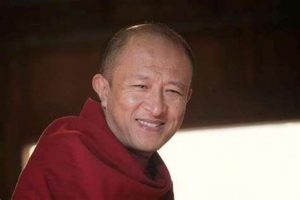The 2000-year-old Silk Road refers to the trade routes and transcontinental economy of Central Eurasia. However, its history is much richer when one looks into its maritime dimension. According to Central Eurasian scholar Christopher Beckwith, the naval passageways and littoral hubs of the Silk Road were particularly important to empires peripheral to the greater landmass of Central Eurasia. China was one of these peripheral empires, and its reliance on the Pearl River Delta and the southern sea routes forever affected the religion, culture, and economy of the lower half of the country.
The concept of the Pearl River Delta is a modern construct that began in the early 1990’s, encompassing a total of 9 cities: Guangzhou, Shenzhen, Zhuhai, Foshan, Dongguan, Zhongshan, Huizhou, Jiangmen, and Zhaoqing. The Greater Pearl River Delta refers to the region of Guangdong, Hong Kong and Macau. Yet as early as the Three Kingdoms period (220 – 265 AD), there are records of Buddhist monks in the Pearl River Delta spreading the Dharma. During the Wei, Jin, Southern and Northern Dynasties, and the Tang Dynasty, monks from India were actively translating sutras and teaching Dharma in the Pearl River Delta. Correspondingly, a number of virtuosos emerged within Chinese Buddhism, including Bodhidharma, the founder of Chinese Zen, the famous translator Paramartha and the ancestor of Chinese Tantrism, Vajrabodhi.
The maritime Silk Road was established by merchants of the Eastern Han dynasty after Emperor Wu (1). It connected China with the seas, and functioned as a “maritime transportation artery” that promoted international trade and cultural exchange. This Maritime Silk Road prospered in the Sui and Tang dynasties and endured well into the Song and Yuan dynasties. Although it reached its peak in the early Ming dynasty, it declined thanks to the Marine Ban in the intermediate period. It consisted of three main gateways:
1. The Toyo route, which connected the Chinese coast to North Korea and Japan;
2. The South Sea route, which linked China’s coastal ports to the Southeast Asian countries;
3. The Western route, which began at China’s coastal ports and ended at the South Asian, Arab and East-African-Coastal countries.
The nerve points of the Maritime Silk Road were Panyu (later renamed Guangzhou), Dengzhou (now Yantai), Yangzhou, Mingzhou, Quanzhou, and Liujiagang. On this route, Chinese silks and porcelain were exported around the world. In return, medicine from Arabia and Europe was imported into China (2).
The maritime communication around the Lingnan Area (Guangdong, Guangxi, Hunan, and Jiangxi provinces) laid the foundation of the Maritime Silk Road very early on in the pre-Qin Yue Kingdom (222 BC). As early as 6,000 years ago or so, ancient canoes had been used off the shores of Lingnan. Ceramics were discovered hundreds of kilometers along the Huiyang plain in the North East Bank. These 5,000 to 3,000-year-old ceramics clearly demonstrated that trade was an influential economic component for the Chinese coast and offshore islands.
From the distribution of unearthed coasters and pottery, stone figures, bronze-drums and historical records of Yue, we know that people in the pre-Qin period in Lingnan shuttled between the South China Sea and the South Pacific Islands. This nautical tradition indirectly influenced the cultures of the Indian Ocean and its islands. We know that the Yue state was capable of manufacturing large 25 – 30-ton turreted wood boats. In the main output of the Nanyue Kingdom was similar in that they manufactured lacquerware, textiles, pottery and bronzes. Imports as enumerated by the ancient documents reveal the acquisition of pearls, rhino (cattle), the hawksbill turtle, dipterocarpaceae and so on (3). Crucial commercial wharfs were Panyu (now Guangzhou) and Xuwen County (now Xuwen).
After unifying China, the Sui Dynasty strengthened the operation of the southeast coast. For example, Guangzhou and Cochin became a famous commercial and foreign trade center; meanwhile, Yian (now Chaozhou) and Hepu were crucial foreign exchange harbors.
The Tang dynasty favored the expansion and opening of the Maritime Silk Road economic development. It adopted an open-minded political philosophy, a trade management system and a set of laws and rules with which it could function on. The sea routes connected China’s north to North Korea, Silla, and Japan, and the south to the Southeast Asian, Indian, Filipino, and Persian countries. From Guangzhou to the southwest sailing-routes, the Maritime Silk Road crossed more than 90 countries and regions on a journey of 89 days(excluding stopover times). The whole journey was about 14,000 kilometers, and it was the longest distant shipping line in the world during the 8th and 9th centuries (4).
Before the second year of Kaiyuan reign of the Tang Dynasty, there was a position called Maritime Trade Commissioner (5). The commissioners reported to the court and managed foreign trade issues, hence making good money for the local and central governments. Also, the local magnates, officials, and civilians operated overseas trade directly and led to mercantile changes in social life.
The major exports still engaged in silk and ceramics, along with iron, swords, saddles, mink, musk, incense, cinnamon, galangal and so on. Ivory, rhino horn, and pearls occupied a significant proportion, and imports also consisted of numerous countries’ specialties. Human trafficking and slavery constituted an important part of the economy, such as those from Kunlun (6).
The Maritime Silk Road continued to prosper until the Qing Dynasty, and it played a considerable role in the social change and the development of Sino-foreign cultural exchanges. The foreign monks made a significant impact on the development of the Pearl River Delta and even Chinese Buddhism along the Maritime Silk Road.
References
(1) Ban Gu, The geographical Records in Han Shu. Beijing: Zhonghua Book Company, 1999.?
(2) Zhenren Yuankai, The Journey to the East of a Great Monk in the Tang Dynasty. Beijing: Zhonghua Book Company, 1999.
(3) Huainan Zi, Huainan Zi. Hong Kong: University of Hong Kong Press, 1985.
(4) Ouyang Xiu, The Geographical Records in The New Tang Annals. Zhejiang: Zhejiang Book Company, 1873.?
(5) Wang Qinruo, Yang Yi and others, Ce Fu Yuan Gui. Hong Kong: ZhonghuaBookCompany,1960.?(6) Liu Xu, The Old History of the Tang Dynasty. China: Dingyuan Fang Runyi, 1872.








